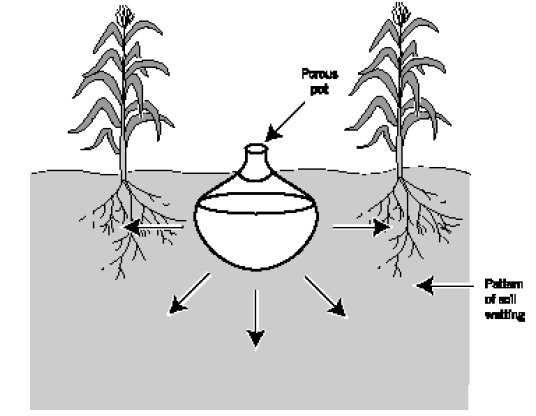Difference between revisions of "Localized irrigation"
(→Manuals, videos and links) |
|||
| Line 28: | Line 28: | ||
===Manuals, videos and links=== | ===Manuals, videos and links=== | ||
| + | * [http://www.thewaterchannel.tv/images/watersmartagriculture_CGIAR_2015.pdf Water-Smart Agriculture in East Africa], a collaborative effort by [http://www.care.org/ CARE], [http://globalwaterinitiative.org/ GWI], [http://www.iwmi.cgiar.org/ IWMI], and [http://www.cgiar.org/ CGIAR]. A 321-page sourcebook for improving water management for smallholder farmers. | ||
* Large wiki on water use for agriculture: [http://agropedia.iitk.ac.in/ Agropedia] | * Large wiki on water use for agriculture: [http://agropedia.iitk.ac.in/ Agropedia] | ||
===Acknowledgements=== | ===Acknowledgements=== | ||
* Sijali, Isaya V. [http://www.samsamwater.com/library.php?serie=RELMA%20Technical%20Handbook%20Series DRIP IRRIGATION: Options for smallholder farmers in eastern and southern Africa.] RELMA, 2001. | * Sijali, Isaya V. [http://www.samsamwater.com/library.php?serie=RELMA%20Technical%20Handbook%20Series DRIP IRRIGATION: Options for smallholder farmers in eastern and southern Africa.] RELMA, 2001. | ||
Revision as of 02:40, 3 November 2015
Localized irrigation systems apply water directly where the plant is growing thus minimizing water loss through evaporation from the soil. Such localized irrigation systems include drip irrigation, porous clay pots, porous pipes, and perforated plastic sleeves.
Porous clay pots

This is a method of irrigation in which water is stored in clay pots buried in the ground, from where it is slowly released to the plants. This method is good for fruit trees. Such use of soil-embedded porous jars is one of the oldest continuous irrigation methods that probably originated in the Far East and North Africa.
The method consists of:
- Clay pots that are placed in shallow pits dug for this purpose;
- Soil is then packed around the neck of the pots so that the necks protrude a few centimetres above the ground surface;
- Water is poured into the pots, either by hand or by means of a flexible hose connected to a water source.
The pots are made of locally available clay with optimum properties of strength (to resist crushing), permeability (to exude water into the soil at an approximately steady rate), and size (to hold enough water for at least one day’s supply).
The potential of clay-pot irrigation has not been fully exploited by farmers in the eastern and southern Africa region, even though the technology is suitable for small scale farmers. There have not been many reports of previous experience in the region.
Porous clay pipes
Water is spread along a continuous horizontal band in the soil. This method is most suited to closely spaced crops such as vegetables. The locally made clay pipes are approximately 24 cm in length and 7.5 cm in internal diameter, with wall thickness of 2 cm. The pipes are placed at the bottom of a shallow trench (about 25 cm deep) representing the centre line of a 1-m wide bed.
Perforated plastic sleeves
Plastic sheeting has been used to make a sleeve-like casing. The advantage of this is the low cost. However, the method has several distinct disadvantages that restrict the range of its applicability. Since the soft plastic material used for making the sleeve does not retain its shape, the sleeve must be filled with sand before being placed in the soil. The sand filling reduces the capacity of the sleeve by some 50–60%. Moreover, the sand itself tends to retain a significant fraction of the moisture and thus to restrict outflow.
Since the plastic casing is essentially impervious, it must be perforated. The difficulty of standardizing the diameter and density of the perforations introduces another variable unto the system. The best configuration must be established by trial and error. This method has been used with success in Senegal. An interesting variation in Sri Lanka consists of a 50-cm long PVC pipe of standard °-inch diameter. The pipe ends in an emitter, a block made from a 1:10 cement/ sand mixture. The design was found to be effective in enhancing the survival and growth rate of young fruit trees.
Manuals, videos and links
- Water-Smart Agriculture in East Africa, a collaborative effort by CARE, GWI, IWMI, and CGIAR. A 321-page sourcebook for improving water management for smallholder farmers.
- Large wiki on water use for agriculture: Agropedia
Acknowledgements
- Sijali, Isaya V. DRIP IRRIGATION: Options for smallholder farmers in eastern and southern Africa. RELMA, 2001.
